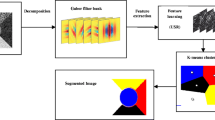Abstract
In this chapter, a polarimetric synthetic aperture radar (PolSAR) image segmentation approach is proposed in the variational framework. A novel continuous Potts model which takes advantage of the complex Wishart distribution is built for PolSAR image segmentation. Moreover, an automatic initialization technique is adopted to initialize the segmentation process. The automatic initialization approach can determine the number of clusters by PolSAR data itself. Compared with previous variational PolSAR segmentation approaches, the proposed approach makes use of the scattering characteristic and statistical characteristic together to segment PolSAR images in a completely unsupervised way. Experimental results demonstrate the effectiveness of the proposed approach. Without any artificial supervision, the proposed approach can produce superior segmentation results than the traditional level set method and \( Wishart - H - \alpha \) classification approach.
Access this chapter
Tax calculation will be finalised at checkout
Purchases are for personal use only
Similar content being viewed by others
References
Fjortoft R, Lopes A, Marthon P, C-Castan E (1998) An optimal multiedge detector for SAR image segmentation. IEEE Trans Geosci Remote Sens 36(3):793–802
Deng H, Clausi DA (2005) Unsupervised segmentation of synthetic aperture radar sea ice imagery using a novel Markov random field model. IEEE Trans Geosci Remote Sens 43(3):528–538
Xia GS, He C, Sun H (2007) A rapid and automatic MRF-based clustering method for SAR images. IEEE Geosci Remote Sens Lett 4(4):596–600
Kass M, Witkin A, D (1987) Snakes: active contour models. Int J Comput Vision:321–331
Osher S, Sethian J (1988) Fronts propagating with curvature dependent speed: algorithms based on the Hamilton-Jacbion formulation. JComput Phys 79(1):12–49
Ayed IB, Mitiche A, Belhadj Z (2006) Polarimetric image segmentation via maximum- likelihood approximation and efficient multiphase level-sets. IEEE Trans Pattern Anal Mach Intell 28(9):1493–1500
Lee JS, Grunes MR, Kwok R (1994) Classification of multi-lookpolarimetric SAR imagery based on complex Wishart distribution. Int J Remote Sens 15(11):2299–2311
Cloude SR, Pottier E (1996) A review of target decomposition theorems in radar polarimetry. IEEE Trans on Geosci Remote Sens 34:498–518
Potts RB (1952) Some generalized order–disorder transformations. Proc Camb Philos Soc 48:106–109
Bae E, Yuan J, Tai X-C (2011) Global minimization for continuous multiphase partitioning problems using dual approach. Int J Comput Vis 92:112–129
Chan T, Golub G, Mulet P (1999) A nonlinear primal-dual method for total variation-based image restoration. SIAM J Sci Comput 20(6):1964–1977
Fang Cao, Wen Hong, Yirong Wu, Pottier E (2007) An unsupervised segmentation with an adaptive number of clusters using the SPAN/H/α/A space and the complex wishart clustering for fully polarimetric SAR data analysis. IEEE Trans on Geosci Remote Sens 45(11):3454–3467
Chunming Li, Chen yang Xu, Chang feng Gui, Fox MD (2005) Level set evolution without re-initialization: a new variational formulation. In: Proceedings of the 2005 I.E. computer society conference on computer vision and pattern recognition (CVPR’05), San Diego, CA, United States 1063–6919/05
Acknowledgments
This work is supported by the National Natural Science Foundation of China under Projects 60802065 and the Fundamental Research Funds for the Central Universities under Projects ZYGX2009Z005.
Author information
Authors and Affiliations
Corresponding author
Editor information
Editors and Affiliations
Rights and permissions
Copyright information
© 2012 Springer Science+Business Media New York
About this paper
Cite this paper
Tan, Y., Cao, Z., Feng, J., Cui, Z. (2012). Variational Segmentation of Polarimetric SAR Image By Using a Continous Potts Model and Automatic Initialization. In: Liang, Q., et al. Communications, Signal Processing, and Systems. Lecture Notes in Electrical Engineering, vol 202. Springer, New York, NY. https://doi.org/10.1007/978-1-4614-5803-6_3
Download citation
DOI: https://doi.org/10.1007/978-1-4614-5803-6_3
Published:
Publisher Name: Springer, New York, NY
Print ISBN: 978-1-4614-5802-9
Online ISBN: 978-1-4614-5803-6
eBook Packages: EngineeringEngineering (R0)




